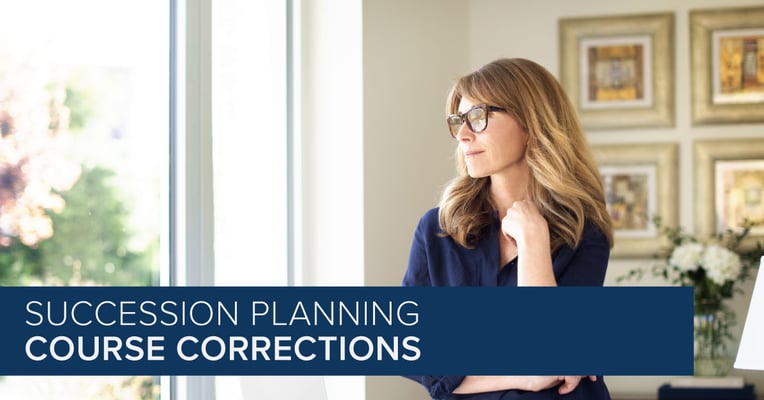Blog
Succession Planning Course Corrections


Succession planning is a critical, foundational element in building a sustainable business. Incorporating new talent into your ownership structure is a process that takes continuous planning, evolution, and monitoring. When done correctly, succession planning ensures incredible employee culture, firm growth, and enduring business value. When the brunt of the planning is complete and documented with the help of partners like FP Transitions, firms have to stay focused as they begin executing their plan. Owners and next generation leaders must engage in transparent communication to navigate the inevitable bumps that can occur throughout the planning and execution of a succession strategy. The reality is, we’re all human. Life presents curves, and personal and professional goals can change. These anticipated bumps can necessitate larger course corrections in order to keep your plan on track.
Typically there are three areas where succession plans may need course corrections: if founder/owner plans change, if successor plans change, and if Plan B needs to be activated.
If Founder Plans Change
The whole purpose of a succession plan is to help your business outlive you, so count on this being a somewhat lengthy process. While some plans on paper may go out 20 or more years, they are implemented tranche by tranche, with planned opportunities for reassessment and course changes or adjustments. At a minimum, plan for annual valuations to monitor value, annual benchmarks using that valuation data to track operational numbers, and plan adjustments every five years or so. Depending on the size of the business, the number of owners, and the goals, some businesses and firms prefer more frequent maintenance so that the course corrections are more subtle.
While there are many reasons why your plans could change, let’s address the more common ones. First is a health issue, or a similar concern, that causes you (G1) to want to significantly accelerate your end of the plan. Second is a dissatisfaction with the performance of the business in the hands of your successor team; perhaps they are just not taking on their responsibilities or you’re still the largest producer of revenue by a wide margin and you don’t see that changing. Third, you decide that what you really want is a lump-sum payout, a large one at that, and you’d like to be done with the whole thing and allow your team to take over and go their own way.
In reverse order, if you want to cash out, you need not be hindered by your G2s’ lack of immediate funds. With recent advances in financing tailored specifically for financial advisors, bank financing is a great tool to accelerate your plan, and one that we’re seeing utilized more and more amongst our clients. You can be substantially cashed out at today’s tax rates, and your succession team gets 10 years to pay for the business of out of its cash flow and future growth. It can be a win-win, if everyone is ready.
If the succession team isn’t stepping up to your satisfaction and you’re unable to resolve that problem with your business partners, then it might be time for Plan B: sell the business to the best-qualified third party and be done with it. Make a plan to sell, and execute it when the time is right–but don’t wait too long. Once you go into attrition mode, value falls fast. To retain the needed level of authority to sell or merge the business, you’ll need to have your plan documents prepared with this possibility in mind. Among the tools you’ll need are drag-along rights and probably tag-along rights, which are part of the paperwork, at least in the early stages of most succession plans. This is also why you need annual valuations to track the equity number and to make decisions proactively and on a fully informed basis.
Finally, if a serious health issue strikes you or a loved one, there are a couple of ways to address this in terms of your participation in your own succession plan. Consider that one of the greatest benefits of owning a business with a strong and collaborative team is that you can rest easy knowing things will continue running smoothly and the clients taken care of should something unexpected take you out of the office for a prolonged period of time. If your succession team is strong enough and you’d prefer to wrap it up, accelerate the process.
If Successor Plans Change
This one is a little trickier and harder to plan for. The first thing to consider here is what you always tell your clients about their investments–diversify your risk.
There are several reasons why a succession plan starts by widening the ownership base. The one that is relevant to this discussion is pretty simple: Supporting an enduring business and being part of the succession team as a G2 or G3 level owners represents a lifetime commitment, and some younger owners simply won’t stay with it for the duration. There could be partnership disputes, health issues, a spouse’s relocation or career change, a divorce, a change in vocation, or even a recession. Your stellar G2 advisor could get a more attractive offer from a larger competitor or decide to start his or her own business. The unexpected happens to everybody.
You may need to adjust your course depending on the decision and/or circumstances of your next generation advisor(s). But just as a course correction of a founder’s creation has options, so does this scenario. And many of these options look the same. If you have time, you can elevate other key employees in your business or conduct an external search for new talent. You can adjust your plans to include a merger or third-party sale. The change in successor’s plan, though, is less disruptive if you have cultivated an ownership team with multiple G2s, where you have the option to continue on course without them.
This is one major reason why you should never tie your future plans, and the value of a business it has taken a lifetime to build, to any one key staff member (and that includes family members) to succeed you. In addition, having more owners (i.e., widening the ownership base) lowers the cost and risk of the investment to G2 and G3 advisor/owners and makes the process less demanding and onerous for them.
A successor’s change of plans may be completely out of your–or their–hands, but in some cases this bump can be prevented by proper structure and communication from the very start; from the moment you begin incorporating the next generation into your ownership structure.
Firstly, do not give your stock away. If you don’t place real value on what you’ve built, neither will your successor or succession team. Share the results of your annual valuation and benchmarking efforts with your team and sell the stock, in small amounts; people tend to value what they work for and have to earn, and they don’t easily leave valuable, hard-earned assets behind.
Additionally, create an ownership position that matters, something that really makes a difference. Give them the opportunity to contribute to key business decisions. Introduce them and support them as owners and leaders with clients and the rest of the staff to show your commitment to their role in the business. Sell them enough stock or membership interest that a change in their plans or their lives revolves around this business opportunity and not some other.
Plan A vs. Plan B
You can do your best to predict any events that might upset your course, and you can do your best to prevent them and put contingencies in place. But, the truth is, some of these situations are out of your hands. And that’s ok!
The good news is that in the process of executing Plan A: preparing for and onboarding next generation talent, you’ve built a strong and valuable business. Unless you’ve started your succession process early enough to begin the successor search all over again–which is, unfortunately, rarely the case for most advisors–you can still realize favorable value through Plan B: selling to (or merging with) a third party. It’s a possibility we’re honest about with our clients, “Prepare for and expect Plan A, but be ready for Plan B.” It might not be your initial vision, but selling to a third party when internal succession doesn’t work out isn’t a bad thing; you retain control over choosing your successor and you still realize incredible value for the business you’ve built. You just take a different path to get there.
.png?width=1200&height=400&name=LETS%20CHAT%20CTA%20(2).png)